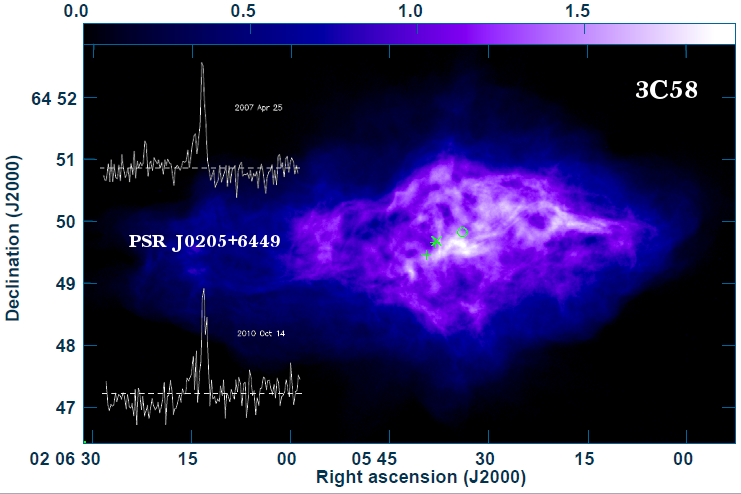Daily Image
11-06-2013Proper Motion of the Young Pulsar in the Supernova Remnant 3C58
| Submitter: | Vlad Kondratiev |
| Description: | Though the supernova remnant 3C58 had long been known as a pulsar wind nebula, the pulsar was not discovered until 2002 in both X-ray and radio. PSR J0205+6449 is at a distance of about 3.2 kpc, has a period of 66 ms and quite low pulse-averaged flux density of only 45 µJy at 1.4 GHz, and is one of the most energetic, and almost certainly of the youngest known pulsars. Pulsar wind nebulae provide important diagnostics for young pulsars, giving insight into the winds which carry away the pulsar spindown energies. Knowing PSR J0205+6449's proper motion is important for determining the nature of its interaction with its surrounding nebula. It is also particularly interesting because of the unsettled question of 3C58's age: its traditional association with the supernova of 1181 A.D. has recently been repeatedly questioned. In particular, the pulsar is offset from the center of the thermal X-ray shell. If the pulsar was at the center of the X-ray shell in 1181 A.D., its proper motion should be ~30 mas/yr, easily measureable with VLBI observations. We employed a novel observing technique in our two-epoch VLBI observations of this young pulsar. We used Green Bank Telescope (USA) simultaneously in the VLBI array and for single-dish pulsar timing using the Spigot or GUPPI backends. The high timing noise of this young pulsar and its glitching nature precludes the determination of the proper motion from the pulsar timing and makes necessary to measure pulsar's period at the epochs of VLBI observations. We derived the position of the pulsar accurate at the milliarcsecond level and determined its proper motion, corresponding to a projected velocity of only 35 km/s for a distance of 3.2 kpc, that is quite low compared to the velocity dispersion of known pulsars of ~200 km/s. We estimated pulsar position at birth, and it seems more likely that age of PSR J0205+6449 and 3C58 is several thousand years, rather than associated with SN 1181 A.D. These results are published in the paper by M. Bietenholz, V. Kondratiev, S. Ransom, P. Slane, N. Bartel, and S. Buchner in MNRAS. The main figure represents a 1.4-GHz VLA radio image of 3C58 from Bietenholz (2006). The cross sign shows the present location of PSR J0205+6449, while the two plus signs mark two possible birth locations: at 1181 A.D. and at 5000 BC. Plots on the right show the average pulsar profile at two epochs of observations. |
| Copyright: | Michael Bietenholz (HRO/York University) |
| Tweet |  |
